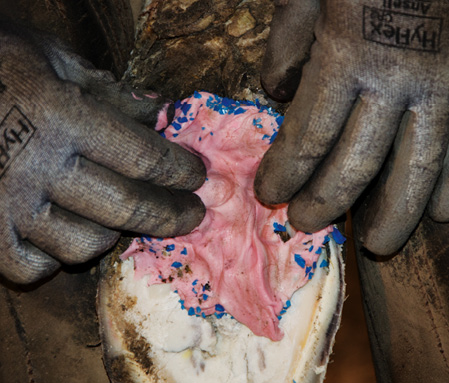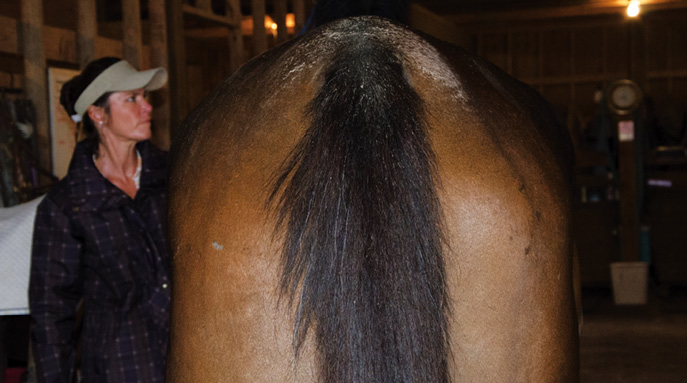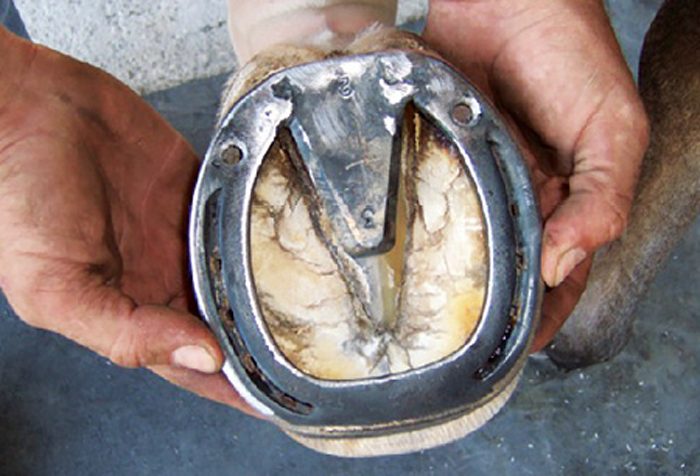If the heels aren’t too compressed when presented with a prolapsed frog on a foot with a negative plantar angle, you can weld some frog support in an open-heeled shoe.
When discussion turns to equine lameness issues, invariably the front feet and legs get the lion’s share of attention.
While front end lameness is more prevalent than in the hind, having sound, fully functional hind legs and feet are essential to any horse.
The hindquarters have three basic functions — they are used to propel the horse, to stop that forward progress and to be a pivot point to change direction. In the course of a horse’s life, the hindquarters undergo a lot of abuse and can wear out and break down.
Often, less attention is given to shoeing the hind feet than the front feet in the belief that the front feet are more important. Obviously this is not the case. This article will attempt to offer some insight into how to keep a horse sound and ways to help it when normal shoeing is not enough.
The Trim
Farrier Takeaways
Less attention often is given to shoeing the hind feet in the erroneous belief that the front feet are more important.
Consider the possibility of a hoof abscess first during the onset of a fast lameness, especially if it’s in one foot.
When a rider of a well-conformed horse notices a decrease in performance and a shortened stride, its hocks could be causing discomfort.
The basis for all good shoeing starts with figuring out what you have to work with and what you can do with it.
Before you start trimming, take a few seconds and study the foot and devise a plan. For short-footed horses, basic principles for trimming apply. You want the coffin bone wings to be the same distance from the ground on both sides with a plantar angle of 1 to 8 degrees.
Since the introduction of the digital radiograph machine, I have seen a lot more hind feet being X-rayed to check medial and lateral balance. Often I have been surprised to find that some feet look very acceptable outwardly, but they have a zero or negative plantar angle.
It’s very important that the technician or vet taking the radiographs do it properly to be useful to the farrier. Both hind feet should be put on blocks with the horse bearing equal weight on both feet. Two views of each foot are adequate; they are lateral and dorsal-palmar. From these two views you can determine how to correctly balance the foot.
Maintenance Shoeing
It is always nice to be able to start with a clean slate on a nice young horse with no wear and tear issues. How long they stay that way depends on their conformation, how young they were when trained hard, the amount of hard training and lastly, the good fortune not to get hurt.
Many younger horses with decent feet can go for years, if they are lucky, with just standard open-heeled shoes.
Horses may hit themselves because that hurts less than something else …
The type and fit of the shoes are going to depend on the discipline the horse is engaged in. Many using Western and polo horses are fit fairly tight at the quarters and heels to prevent the shoes from being pulled off when they are crowded in trailers, doing cow work or playing polo.
Sport horses doing jumping events or dressage can get away with a longer, fuller shoe because they generally go in individual turnout and need the extra caudal support for support and balance.
Types Of Lameness In The Back End
It’s the rare horse that does not encounter some kind of lameness issues sometime during its career. These can range from having to take a few days off to career or life threatening.
Because of the frequency that farriers see clients’ horses, often we can get subtle signs of problems on the horizon. So, it’s good to be proactive in communicating this information to the attending vet and client.
Some of the problems can be dealt with farriery, while some cannot. It’s important to know the difference. There is the old cliché about the carpenter who thinks everything can be fixed with a hammer and nails, the surgeon thinks he can fix everything with a scalpel and the farrier who believes that all lamenesses can be fixed with shoeing tools and shoes.
Abscesses. The onset of lameness can be fast or slow. With any onset of a fast lameness, especially if it’s only in one foot, consider the possibility of a hoof abscess first.
Toe dragging usually is a riding problem …
Pull off the shoe and do a thorough exam of the foot using a wire brush, hoof knife and hoof tester. There’s the old saying about “when you hear hoof beats, think horses not zebras.” Eliminate the most common causes before getting into the exotic.
Sore or collapsed heels with a negative plantar angle. As I stated earlier, the digital radiograph machine is being used more and more on the hind feet to determine balance. I believe this is critical to keeping horses sound longer. Over time, negative plantar angles can start to adversely affect all the joints in the upper leg.
Correcting a negative plantar angle can be as simple as being more aggressive trimming the toe than normal. This is where the lateral radiograph view is so beneficial because you can see exactly how much sole thickness you have at the toe. I think you might be in for a big surprise with some of your horses.
Often, you might be out of foot to trim with a prolapsed frog trying to make contact with the ground. In these instances, you have a couple choices.
If the heels are not too compressed, you can weld some frog support in an open-heeled shoe. If you need to gain some elevation at the heel, I prefer to use a 2-degree Castle wedge pad with a frog support.
With some horses, after you pull the shoes, the frog and the heels will level out and you can apply the shoe and pad immediately.
On severe cases, especially one in which a rim wedge pad has been used and really pushed up the heels, it may be prudent to wrap up the unshod foot, put it in a stall overnight and shoe it the next day.
My favorite hoof packing is pink dental impression material that has been mixed with a tablespoon of copper sulfate. This works extremely well to diminish the bacteria under the pad and keep the bottom of the foot nice and healthy.

Pink dental impression material mixed with copper sulfate does a great job of diminishing bacteria under a pad.
Sore hocks, sore stifles, short stride, unilateral or bilateral lameness. Horses are like anything you use hard. Eventually they will wear out.
Often the hocks are the first to go in a well-conformed horse. Signs of this are the rider noticing a decrease in performance and a shortened stride. The farrier picks up on this when the horse is reluctant to pick up its feet, wanting to take it back and maybe taking a gimpy step when it does get to set it back down.
If you have a horse with a balanced foot and well shod with an open-heeled shoe, I prefer not to change the shoeing.
What we have here is a medical problem that usually is solved by having its hocks “done.” Done means the hocks are injected with hyaluronic acid or HA.
The substance has been around now for about 30 years and has proven quite effective in relieving the pain in deteriorating hocks. You might want to blunt up the toes on the shoe somewhat and put a roll on it, but don’t get carried away trying to fix this with shoeing.
Mild suspensory lameness. In the past few years, especially in the sport horse disciplines, the diagnosis of suspensory ligament tears or holes is becoming much more common. This might be because many vets now carry an ultrasound machine.
Historically, the shoeing prescription from the vet was to put on some kind of caudal support shoe like an egg bar to keep the foot stable.
The new shoe on the block for suspensory problems is a wide toe and penciled heels.
This is prescribed to keep the horse in work so it can go to the next show. The theory is that when loaded on soft ground the heels will sink, loading the deep flexor tendon and taking the stress off of the suspensory ligament.
Personally, I have reservations about this approach. It seems to me that preventing the toe from sinking into the ground as it would normally do in the long run is going to create more problems.
Instead, I think more thought should be given to long-term soundness, which would mean that the horse needs some time off to heal. Unfortunately, with the show seasons that never end, the horse has become more expendable.
Serious suspensory breakdown. Complete suspensory breakdown is a totally different deal. The suspensory ligament’s function is to keep the fetlock from descending all the way to the ground when the muscles become fatigued and can no longer function properly.
Suspensory breakdown most often is seen in older horses, particularly brood mares with long pasterns and horses that have had a long, hard showing career.
In the early stages, an egg bar or full-support shoe may be useful. Do not think that having the shoe extend beyond the back of the bulbs of the heels helps. It only makes it more difficult for them to drag around. Horses do not come back from this kind of breakdown. Often, owners are reluctant to put them down, but usually it is the kind thing to do.
Lameness due to uneven hips. Occasionally at reset time, you will come across a horse that has one shoe as thin as aluminum foil and the other shoe looks like it was put on the day before. In this situation the horse is trying to get off one leg (the one with the thick shoe) and putting all the weight on the leg with the thin shoe.
Often, the cause of this is a horse with uneven hips. If you stand behind them and put your fingers on either side of their hip sockets, you might find that one is a bit higher than the other.
The remedy for this is to put a shoe and a thick leather pad on the leg with the dropped-down hip.
It might take a shoeing cycle or two but most of these down hips will level off and you can discontinue the use of the pad.

When pulling shoes, if you find that one looks thin while the other has little wear, the horse might have a lameness as a result of uneven hips. A shoe with a thick leather pad on the right hind leg, which has a lower hip, can help such as the one pictured.
Ankle hitting. Hind end ankle hitting is a serious problem, but usually isn’t a shoeing problem. Again, if the horse is properly shod and has not been hitting itself, something else most likely is the cause.
Horses do not start hitting themselves because it’s fun. They hit themselves because that hurts less than something else bothering them. Here the aid of a sharp vet who can palpate the leg for soreness is invaluable.
I had an incident in which two horses were reset on the same day and started hitting themselves. The owner had been at a horse show at the time and her immediate response was, “What did you do to my horses? They have never hit themselves before.”
The next day I went to take a look and they were banging their ankles terribly. Luckily for me she used an experienced vet who identified extreme muscle soreness. The mystery was solved when it was found that the grooms had left these two horses turned out about twice as long as was normal. In their anxiety about getting back in the barn, they had started running the fence and repeatedly sliding to stop in the corners.
The two were given some time off, the ankle hitting stopped and we all lived happily ever after. The moral of the story is do not be so quick to make changes until you have all the facts.
Toe dragging. Toe dragging usually is not a shoeing problem but a riding problem. It usually occurs in lesson horses that go around and around a ring in a trance. If the ring is limestone, it will be abrasive and can wear the hoof wall back to the insensitive laminae.
The easy solution is to have the instructor put the more aggressive students on these horses and wake them up. The other solution is to fashion a toecap shoe and draw it out and extend it up the toe.
Forging. Often forging is another example of the lazy horse, lazy rider syndrome. If the rider can be persuaded to pick the horses head up, put him in a frame and put some leg on him, the problem may disappear.
My shoeing solution for forging was to use the lightest shoes possible. Blunt the toe of the shoe a bit on both front and hind. I dislike pointy-toed shoes.
On the hind feet, set the shoe back to the inside of the wall and let the toe of the foot extend over the toe of the shoe. Often this will change the timing and arc of the feet and the miss of a fraction of an inch is as good as a mile.
Details, Details
Shoeing the hind feet is like brain surgery in that it’s easy if you know how. The devil is in the details. Pay as much attention to the hind feet as you do the fronts and you will find you will have less problems overall. Keep it as simple as possible and good luck.









Post a comment
Report Abusive Comment